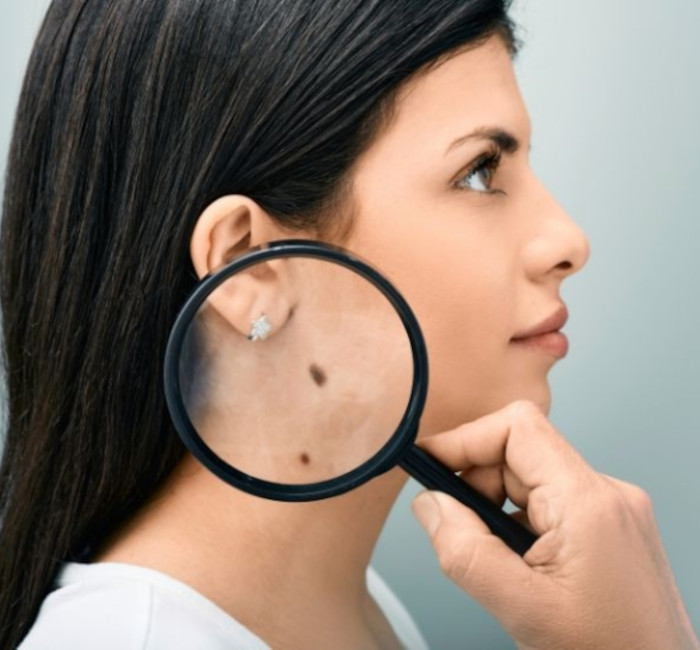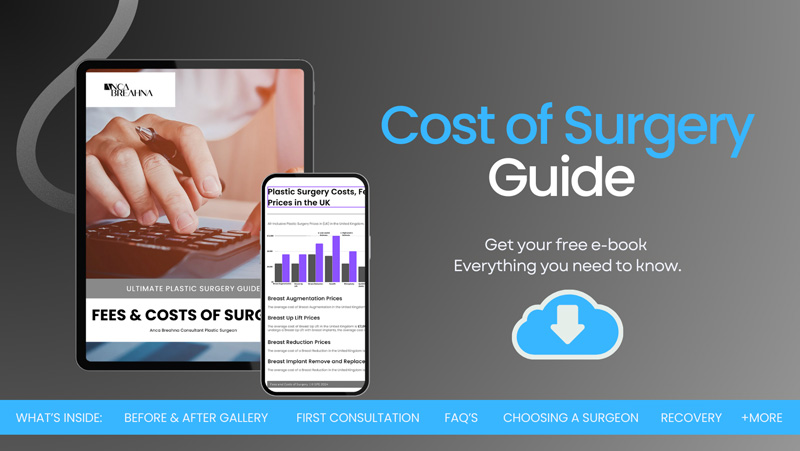Procedures
Biopsy Incision

When it comes to medical diagnostics, when doctors encounter anomalies within the body that require closer examination, a Biopsy Incision often becomes a necessary step. This procedure might sound intimidating at first, but understanding its purpose and process can alleviate many concerns. Essentially, a Biopsy Incision is a surgical intervention designed to extract a small sample of tissue from your body. This sample is then meticulously analysed in a laboratory setting to determine the presence or nature of a disease, such as cancer.
The decision to proceed with a Biopsy Incision follows a series of preliminary assessments and tests that suggest an irregularity requiring further investigation. The importance of this procedure lies in its ability to provide concrete evidence.
Chester Consultant Plastic Surgeon Anca Breahna, as a qualified and experienced plastic surgeon, possesses the requisite skills and expertise to perform a Biopsy Incision procedure with precision and care.
At a glance
Depends on the type of procedure perfomed
Local or general anaesthesia
A few days
Table of Contents
What is a Biopsy Incision?
A Biopsy Incision is a precise surgical procedure aimed at diagnosing diseases by examining tissue directly from the source. Whether there’s an unexplained mass, an abnormal skin change, or a concern raised by imaging tests, a Biopsy Incision allows to investigate further. This procedure is particularly significant in the context of cancer diagnosis, where identifying the disease at its earliest stage can greatly influence treatment success.
During a Biopsy Incision, Anca makes a small cut on your skin to access and remove a piece of tissue from the area of concern. This sample is then sent to a pathology lab, where specialists examine it under a microscope to detect any signs of disease. The results from this analysis are crucial; they can confirm or rule out the presence of cancer, identify infections, or highlight other conditions.
One of the main advantages of a Biopsy Incision is its ability to provide a definitive diagnosis. While imaging tests like MRI or CT scans can reveal areas of concern, they cannot always determine the nature of the problem. A biopsy bridges this gap by offering a clear picture of what is happening inside your body at a cellular level.
The procedure is typically performed under local anaesthesia, which means you’ll be awake but won’t feel pain in the biopsy area. The specifics of the procedure vary depending on the location of the tissue being examined and the amount needed for a reliable diagnosis. Despite the variety in biopsy techniques, the goal remains the same: to obtain a tissue sample that can shed light on your health status, paving the way for appropriate treatment.
Who Needs a Biopsy Incision?
A Biopsy Incision becomes a consideration for individuals where there’s a suspicion of an underlying condition that cannot be conclusively diagnosed through less invasive methods. If you’ve undergone preliminary screenings or imaging tests that have identified anomalies—such as lumps, unusual masses, changes in tissue appearance, or unexplained symptoms—your medical team may recommend a biopsy as the next step. This procedure is particularly pertinent in cases where there’s a possibility of cancer, as it can provide a definitive diagnosis and help determine the extent of the disease.
Moreover, individuals experiencing symptoms that do not have an apparent cause, or those who have had previous tests that suggest the presence of a serious condition, might also be candidates for a biopsy. It’s a way for doctors to gather essential information when other diagnostic tools fall short of providing clear answers.
It’s important to understand that being advised to undergo a Biopsy Incision does not automatically mean that you have a serious disease. The procedure is a diagnostic tool—part of a complex approach to figuring out what’s happening inside your body. It allows doctors to gather the information needed to make informed decisions about your care, potentially ruling out severe conditions or confirming a diagnosis that would benefit from early treatment.
Benefits of the Biopsy Incision Procedure
It provides a high level of diagnostic accuracy. While imaging tests can detect abnormalities, they cannot always clarify the nature of these findings. A biopsy, however, can conclusively determine whether a suspicious area is benign or malignant, what type of cells are involved, and the aggressiveness of any disease present. This level of detail is indispensable for formulating an effective treatment plan.
Another advantage of a Biopsy Incision is the tailored treatment it enables. With precise information about the nature of a disease, your doctor can design a treatment strategy that is specifically suited to your condition. For cancers, this might mean identifying the most responsive treatments to the specific type of cancer cells present. In non-cancerous conditions, it could lead to targeted therapy that addresses the underlying cause of your symptoms.
Furthermore, a Biopsy Incision can offer peace of mind. The uncertainty of not knowing the cause of a medical issue can be distressing. By providing clear answers, a biopsy can alleviate the anxiety associated with ambiguous symptoms and inconclusive tests. Even if the diagnosis confirms a serious condition, knowing exactly what you’re dealing with allows you and your healthcare team to take decisive action.
The procedure also plays a critical role in ongoing disease management. For patients already undergoing treatment for a condition, a Biopsy Incision can assess the effectiveness of the therapy and guide adjustments to the treatment plan if necessary. It’s a tool that supports not just the initial diagnosis but the entire treatment journey, ensuring that care remains as effective and responsive as possible.
Types of Biopsy Procedures
Excisional Biopsy
This procedure involves the removal of an entire lump or suspicious area for examination. It is often employed when there’s a palpable mass that needs to be fully removed to determine whether it’s benign or malignant. Excisional biopsies are common in breast lump investigations, where removing the whole lump can simultaneously serve as a part of treatment if the lump is found to be cancerous.
Incisional Biopsy
In situations where a mass is too large to be entirely removed, or in cases where it’s located in a challenging or risky area, an incisional biopsy is performed. This involves taking only a portion of the tissue for analysis. The primary aim is to obtain a sample that is representative of the abnormality without the need for complete removal at this stage of diagnosis.
How is the Biopsy Incision Performed?
The Biopsy Incision procedure is meticulously planned and executed to ensure both accuracy in diagnosis and your comfort and safety. While the specifics can vary depending on the type of biopsy and the area of the body being examined, most procedures share a common structure:
Preparation
The process begins with preparation, which may involve fasting for a certain period if general anaesthesia is to be used. The biopsy area is then cleaned, and a local anaesthetic is applied to numb the region, minimising discomfort during the procedure.
The Biopsy
For an incisional or excisional biopsy, a small incision is made in the skin to access the tissue of interest. The necessary amount of tissue is removed, with the aim of obtaining a sample that is sufficient for diagnostic purposes without causing unnecessary damage to the surrounding area.
Closure and Recovery
Once the sample is obtained, the incision is closed with stitches, if necessary, and bandaged. The procedure usually takes a short time, and you can often go home the same day, although you may need someone to drive you if you’ve had sedation or general anaesthesia. The biopsy site may be sore for a few days, and you’ll be given instructions on how to care for it.
The tissue sample is sent to a pathology laboratory, where it is analysed under a microscope by specialists.
Each biopsy type has its specific applications, benefits, and considerations. The choice of biopsy procedure depends on multiple factors, including the location, size, and nature of the suspicious area, as well as the overall health and circumstances of the patient. Your healthcare provider will recommend the most appropriate type of biopsy based on these factors, ensuring that the procedure is both safe and likely to provide the necessary diagnostic information.
Recovery after the Biopsy Incision
Recovery from a Biopsy Incision is generally straightforward, but it varies depending on the type of biopsy performed, the specific area of the body involved, and individual healing responses. The following guidelines aim to help you understand what to expect during the recovery period and how to care for yourself to ensure the best possible outcome:
Immediate Post-Procedure Care
Immediately after the procedure, you might experience mild discomfort, swelling, or bruising at the biopsy site. These symptoms are normal and usually subside within a few days. If a larger incision was required, or if the biopsy was performed in a sensitive area, recovery might take slightly longer.
Anca will give you specific instructions on how to care for the biopsy site. This may include:
- Keeping the area clean and dry
- Changing bandages as directed
- Taking prescribed medications, such as pain relievers or antibiotics, to manage discomfort and prevent infection
- Avoiding strenuous activities or heavy lifting to prevent bleeding or exacerbating any soreness
Monitoring for Complications
While serious complications from a Biopsy Incision are rare, it’s important to be vigilant during your recovery:
- Increased pain, swelling, or redness at the biopsy site
- Signs of infection, such as fever or pus from the incision
- Persistent bleeding or oozing from the incision site
- Any other symptoms that cause concern
Reviews
Patient satisfaction is the top priority for Anca. You can find how patients feel about her work below.
Miss Breahna removed a cancerous nodule from my forehead in March 2021. I was quite nervous when I arrived at the hospital, but when I was greeted by a member of her team I started to feel calmer as they were so professional and friendly.
Once inside the theatre Miss Breahna and her team helped me to feel relaxed and comfortable throughout, the team atmosphere was friendly and upbeat during my operation and I was looked after wonderfully. I would recommend Miss Breahna and her team to anyone requiring this type of surgery.
Kate Hodson

Ms Anca Breahna was most kind and empathetic during my recent procedure for skin cancer. She reassured me that I’m now completely clear, I have total confidence in her and would recommend her unreservedly. Thank you Anca.

Wish I’d Done It Sooner! I am so pleased with the results
After searching and deliberating for a long time, I consulted Anca regarding the removal of 3 lipomas. From start to finish, she was fantastic! One of the lipomas was on my forehead and I have to search for the scar! I am so pleased with the results of all and the one regret is that I didn’t find her sooner. I wouldn’t hesitate to recommend her
How Much Is Biopsy Incision in the UK
In the UK, the cost of a biopsy incision can vary significantly based on several factors including the type of biopsy, the complexity of the procedure, the healthcare setting, and geographic location. Please contact us for an estimated price range. This variation often reflects whether the biopsy is performed in a public NHS facility, where costs might be lower or covered by the NHS, or in a private clinic, where fees tend to be higher. Additional costs may also apply depending on the need for specialised diagnostic analysis or follow-up care.
Cost of Surgery Guide

Further Reading
- Read Anca’s Blog on Treatment Options for Lipoma and Other Swellings
- Read Anca’s Blog on Breast Implant Illness – BII Update 2024
- Read Anca’s Blog on Causes and Treatments for Capsular Contracture

Procedure
Frequently asked questions
What are the risks of the Biopsy Incision?
Although a Biopsy Incision is a commonly performed and generally safe procedure, like any medical intervention, it carries some risks. The risk of infection is present with any procedure that involves breaking the skin. Anca will take steps to minimise this risk by using sterile techniques and may prescribe antibiotics if there’s a higher risk of infection. Signs of infection include increased redness, warmth, swelling, and discharge at the biopsy site, along with fever. Minor bleeding at the biopsy site is common, but significant bleeding is rare.Some discomfort at the biopsy site is expected, but this is usually manageable with over-the-counter pain relievers.
How long does it take to get results from a Biopsy Incision?
The time frame for receiving biopsy results can vary, typically ranging from a few days to a week or more. This depends on the complexity of the analysis required and the workload of the laboratory. Your healthcare provider can give you a more specific estimate based on your individual case.
Will I need someone to accompany me for the procedure?
For most Biopsy Incisions performed under local anaesthesia, you may not need someone to accompany you, although it’s often recommended for comfort and support. However, if your procedure requires sedation or general anaesthesia, you will need someone to drive you home afterwards as you may be groggy and unable to drive safely.
Can I eat or drink before a Biopsy Incision?
If your biopsy is to be performed under local anaesthesia, you can typically eat and drink as normal before the procedure. However, if you’re receiving sedation or general anaesthesia, you’ll likely be asked to fast for a certain period before the biopsy. Anca and her team will give you specific instructions based on the type of anaesthesia to be used.
Is a Biopsy Incision painful?
While the biopsy site may be tender or sore for a few days after the procedure, severe pain is uncommon. The area will be numbed with local anaesthesia during the biopsy, so you shouldn’t feel pain during the actual procedure. Any post-procedure discomfort can usually be managed with over-the-counter pain relief medications.
How should I prepare for a Biopsy Incision?
Preparation for a biopsy can vary depending on the specifics of the procedure. Generally, you may be asked to:
- Provide a full list of medications you’re taking, including over-the-counter drugs and supplements, as some may need to be paused
- Follow specific guidelines regarding eating and drinking if sedation or general anaesthesia is planned
- Wear comfortable, loose-fitting clothing to the appointment
- Arrange for someone to drive you home if sedation or general anaesthesia will be used
Medical References about Biopsy Incision
- Techniques of Skin Biopsy and Practical Considerations – PubMed
- Biopsy: Types of biopsy procedures used to diagnose cancer – Mayo Clinic
- What Is a Biopsy? Purpose & Results – Cleveland Clinic
- Skin biopsy – Mayo Clinic
- What is a skin biopsy? – American Academy of Dermatology
 Ms Anca Breahna, PhD, MSc, FEBOPRAS, FRCS (Plast) is a highly regarded Consultant Plastic Surgeon specialising in the field of Aesthetic and Reconstructive Plastic Surgery. Anca performs a range of
Ms Anca Breahna, PhD, MSc, FEBOPRAS, FRCS (Plast) is a highly regarded Consultant Plastic Surgeon specialising in the field of Aesthetic and Reconstructive Plastic Surgery. Anca performs a range of 